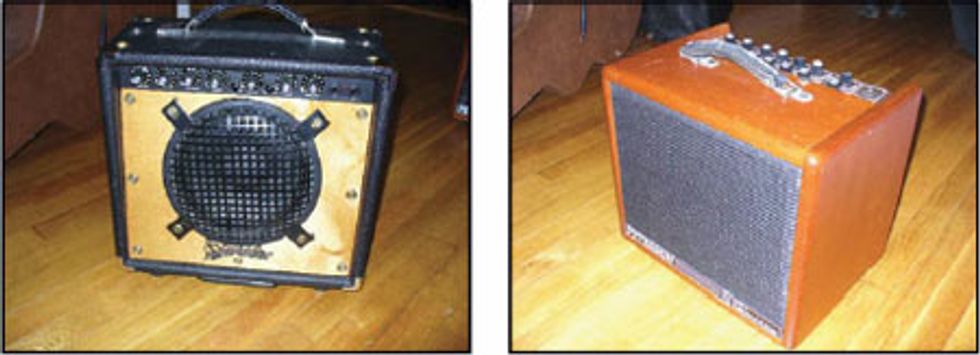In keeping with PG’s theme this month of unique, rare instruments and accessories, we are going to look at two rare birds among jazz amplifiers. Since the beginnings of our
In keeping with PG’s theme this month of unique, rare instruments and accessories, we are going to look at two rare birds among jazz amplifiers. Since the beginnings of our electrified archtop tradition, circa 1940, jazz guitarists have tended to gravitate towards the highly portable combo amp. This is to be expected, since most jazz venues tend to be small clubs, restaurants and coffee houses where low volume amplification is needed – although, if you throw a B3 into the mix you’d better have an amp with more headroom than your average guitar-bass-sax trio calls for! Since the seventies, the Polytone Mini-Brute has played a large role in filling that portable jazz amp niche, but more recently some new players have entered the market, including Evans, Henriksen, JazzKat, Clarus, Raezor’s Edge and Acoustic Image. The two traits they all share are small size and big power.
The two rare-bird jazz amps we are spotlighting are both highly portable and have good power, a clean tone for jazz applications, reverb (the only effect needed for traditional jazz guitar) and a pleasing, traditional design. Both are also very hard to find in today’s used market.
The Evans AE100 was but a brief flash in the pan in the late-nineties and listed for nearly $1000 with its cover. I recall that when this amp was in the design stage, Scot Buffington at Evans related to me that a person could walk to their gig with guitar strapped on their back, the AE100 in one hand and an ice cream cone in the other. This seemed entirely possible, since the AE100 weighed in at 28 pounds and was barely 14” wide. The amp has all the controls found in their larger models, and in fact, the electronic portion seems to be exactly the same as that found in the JE200. Traditional controls of Volume, Master, Treble, Bass, and digital reverb are present, along with Evans’ own EQ controls for Depth, Body and Expand. Add “Scruff” to that if you want some edge and grit in your sound. Ever in a state of evolution, this control has been replaced by “Buff” on newer Evans amps.
 | |
|
The AE100 pictured has a post-factory reworked grille; from the factory, the amp would have had a Fender-style black grille cloth. This example also underwent a speaker swap for a 200-watt Beyma 8” bass speaker, resulting in even greater headroom and a darker jazz tone, along with a significant increase in weight. Scot told me this model was conservatively rated at 100 watts RMS, but was probably actually over 150. No longer in production – the niche was likely filled by their Ron Escheté amp with a 10” speaker – the AE100 stands as a collectible example of great power, Sherman tank construction and an appealingly small size.
The Peterson Guitar Special P100G filled a similar high-power/compact niche but comes from across the pond. Our British cousins (the now-defunct Peterson Amplification of Norfolk, England) manufactured this amp between the mid-eighties and early-nineties. It seems to have all but vanished from the planet and there is little information to be found. The example shown is compliments of Howard Alden.
We might call the Peterson a “manufactured boutique” amp. It came in a beautiful hardwood mahogany cabinet and was available with an optional metal flight case. Traditional controls included Low, Mid 1, Mid 2, High, Reverb and Master Volume, with two channels and switching capability. With higher quality components and construction than comparable Polytone models, Peterson amps, though short-lived, are sought after in the used market and command good prices.
In performance, the Petersons are fine amps for recreating an acoustic archtop tone, similar to that offered by the Polytone models. It is presumed that this model is 100 watts RMS, and while offering more cutting power than Polytone amps, the Peterson does not match the headroom and cutting power of the Evans AE100. This amp came factory loaded with a 12” EV, and it is this writer’s opinion that no current speaker can match an EV for a dark, neutral tone – perfect for jazz archtops. Some of the new amplifiers have tended to go with lightweight speakers as a way of increasing portability; unfortunately, the tonal sacrifice is not worth the weight savings! Finally, the Peterson seems to have suffered the same spotty pan reverb performance of the Polytones, but is nevertheless a fine, high-end jazz amp and very collectible.
So for those players that admire the finest small amp construction available, these rare birds may be worth the time spent hunting for them.
Jim Bastian
A clinician and jazz educator, Jim Bastian is a 10 year veteran of teaching guitar in higher education. Jim holds two masters degrees and has published 6 jazz studies texts, including the best-selling How to Play Chordal Bebop Lines, for Guitar (available from Jamey Aebersold). He actively performs on both guitar and bass on the East Coast.
An avid collector and trader in the vintage market, you can visit Jim’s store at premierguitar.com (dealer: IslandFunhouse).
